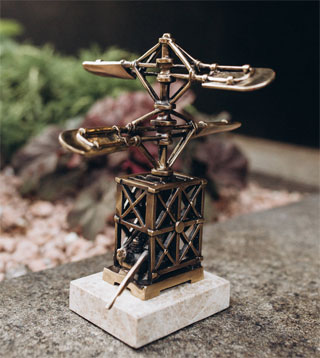|
Sikorsky Helicopter Mini Sculpture opened on 19.06.2019 in Kiev |
The installation of the sculpture is a part of tourist project "Search" created by travel guide Yulia Bevzenko. Author of Sikorsky Helicopter Mini Sculpture is sculptor Yurii Biliavskii. This moment there are other main symbols of Kiev that are presented in mini-sculptures around Kiev city center - Chicken Kiev, Kiev Chestnut, Kiev Cake, Kiev Tram, Kiev First Car Benz Velo, Kiev Brick Plinfa, Kiev Elephant, Kiev Gramophone, Kiev Golden Pectoral, Fountain of Samson, Kiev Computer, Golden Gates, Kyrylo the Tanner, Serge Lifar Golden Shoe. History of Sikorsky Helicopter №1, №2 and Vought-Sikorsky VS-300 (S-46) In 1908 student Igor Sikorsky decided to start building a helicopter that could take-off and land without a runway, hang in the air and make air movements that no possibile for an airplane. He made a rotor of a little more than a meter in diameter out of thin wooden planks, fastened it to a wooden shaft and installed this device on semblance of weights which were to measure the force of a rotor thrust. The energy needed to spin the rotor was measured by a load tied to a string, the other end of which was pulled through the unit and wound on the shaft of the rotor. This device gave the initial data for the calculations which made it possible to conclude that the helicopter could be built with the engines that existed at that time. To continue his work Igor Sikorsky went to Paris to gain knowledge and experience, buy an engine and other necessary materials. The young helicopter designer stood for hours at Issy-les-Moulineaux and Juvisy-sur-Orge airfields, visited one of the pioneers of aviation Ferdinand Ferber. After visiting several factories and workshops Igor Sikorsky chose Anzani engine. The three-cylinder air-cooled engine developed a power of 25 hp was simple, light and reliable. Here he also ordered some parts for the future helicopter made according to sketches of Igor Sikorsky - coaxial shafts and other elements of the transmission. On May 1, 1909 Igor Sikorsky returned to Kiev. In the garden near Sikorsky family house there was a small gazebo which became the first aircraft factory of the designer. In July 1909 the construction of Sikorsky Helicopter №1 was completed. The base of the apparatus was formed by a rectangular wooden cage connected by a piano wire without a chassis.The Anzani engine was installed directly on the floor at one end and the pilot’s seat was located at the other end. The engine by means of a belt drive and three bevel gears supplied power to the coaxial bearing screws. The shafts were mounted one on the other with bearings. The diameter of the rotors was different: the top one was - 4.6 m and the bottom one was 5 m. The rotors rotated in opposite directions with a frequency of 160 rpm. The power base of each blade was two wooden spars that converged crosswise at the attachment point on the shaft. Plywood ribs covered with canvas were attached to the side members. The total weight of the helicopter was 205 kg. During the first tests Igor Sikorsky met with the problem of resonances and strong vibrations that are typical of helicopters. Even eliminating all techniqual problems it became clear that even in full gas the rotors take-off most of the weight of the machine but they cannot take it off the ground. Next Igor Sikorsky created the scales which allowed to measure the lift of the helicopter. Scales made it possible to determine that the thrust corresponds to approximately 160 kg which is 45 kg less than the weight of an empty machine. It was necessary to make the helicopter more lighter in construction, install more powerful engine and more advanced and larger-sized blades with improved aerodynamics. In the history of aviation Sikorsky Helicopter №1 entered as a helicopter which was fully completed and was completely tested. After the first attempt Igor Sikorsky again visits Paris and returns to Kiev with two Anzani engines with 25 hp and 15 hp. The construction of Sikorsky Helicopter №2 was completed in early spring of 1910. The helicopter retaining the general scheme of Sikorsky Helicopter №1 and was completely updated. The whole structure has been lightened to a minimum. Sikorsky Helicopter №2 had a height of not more than 3.5 m. The diameter of the top rotor was 5.4 m, the bottom one - 5.8 m. The mass of the empty helicopter was 182 kg. The 25 hp Anzani engine was installed across the front of the helicopter and the pilot was right behind him under the gearbox. The rotors of Sikorsky Helicopter №2 were three-bladed. All of their power structure with the exception of steel main shafts and bushings was wooden. The blades were like small airplane wings. They were covered with a percale. Tests of the helicopter fixed on the ground showed that the lifting force of the rotors was equal to the mass of the empty Sikorsky Helicopter №2. There was no hope to take-off with a pilot. So Igor Sikorsky realized that at the moment it is no possibile to build truly flying helicopter. At the end of May 1910 he stopped testing his helicopter and used Anzani engine for his first airplane. Anyway Sikorsky Helicopter №2 became the first helicopter capable of lifting its own weight. Vought-Sikorsky VS-300 (S-46) is the first helicopter designed by Igor Sikorsky in United States after its emigration. Number 300 was fixed by the third helicopter built by Igor Sikorsky taking into account two helicopters - Sikorsky Helicopter №1 and Sikorsky Helicopter №2 built in Kiev. September 14, 1939, Igor Sikorsky take-off Vought-Sikorsky VS-300 off the ground. The flight was carried out on a leash a few meters from the ground. After alteration and repair that followed the accident as the helicopter overturned on May 13, 1940 Igor Sikorsky first flew without a leash. So it takes more than 30 years till the moment Igor Sikorsky's helicopter dream come true. At the beginning of 1941 Sikorsky Aircraft company were evaluated by the leadership of US Air Force and financial support was provided for the development of the helicopter VS-316 (S-47) or XR-4 - the world's first serial production helicopter. In October 1943 the third helicopter of Igor Siktorsky Vought-Sikorsky VS-300 was transferred to Henry Ford Museum in Dearborn, Michigan, USA where fans of aircrafts and helicopters could watch it now. Since November 2015 Sikorsky Aircraft Corporation became a part of Lockheed Martin Corporation - the world's largest defense contractor. Organizers of Sikorsky Helicopter Mini Sculpture
Team of Project "Search" |
Information about Kiev Hotels, Hostels, Restaurants, Supermarkets on Kiev Map
|
|

Book your tour or request information: |
|
- please, look at reviews of tourists about our tours
|
© 2011 - 2025 All rights reserved |


